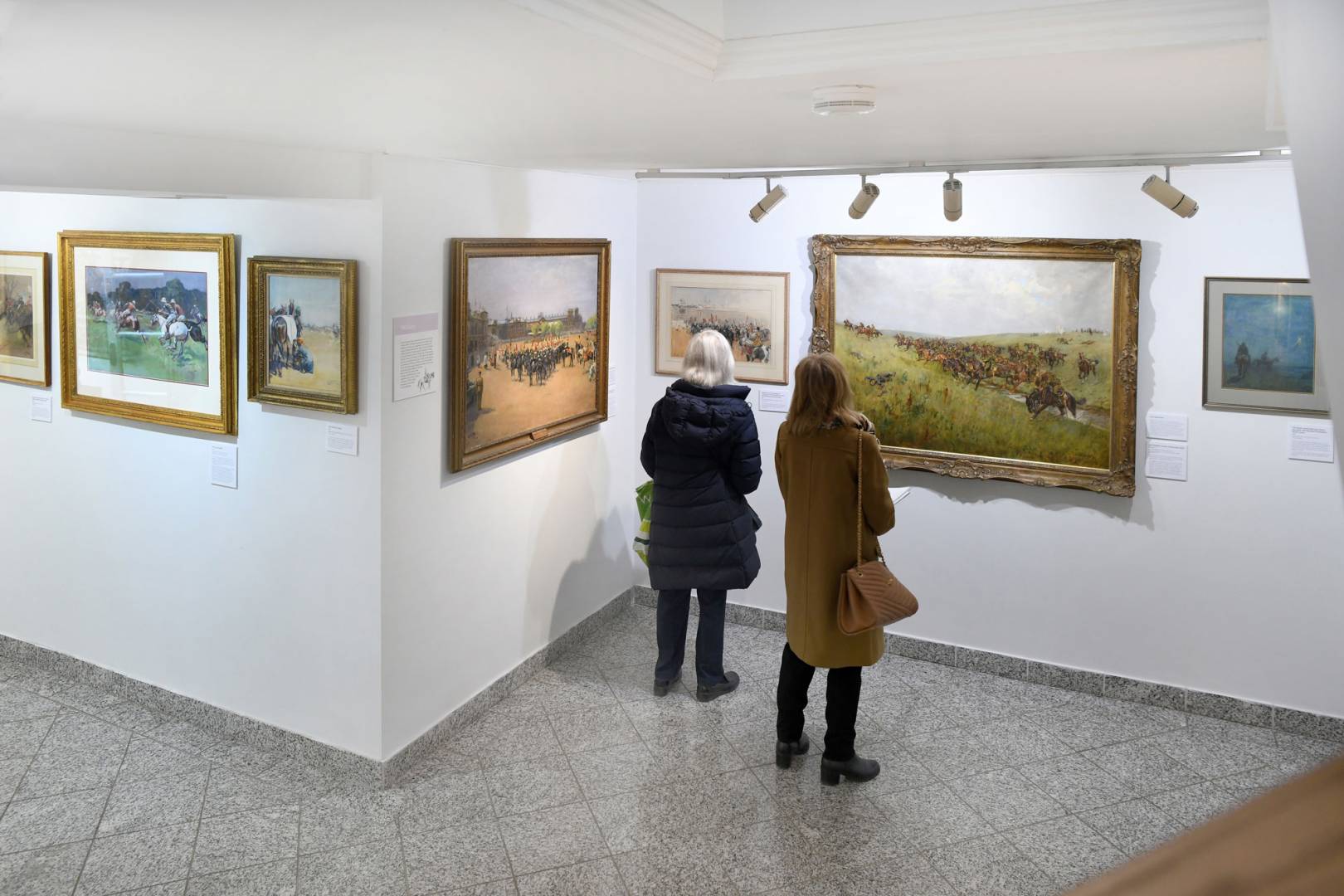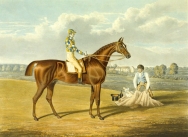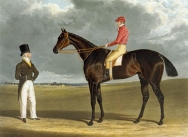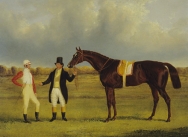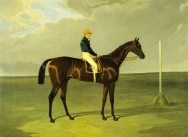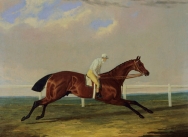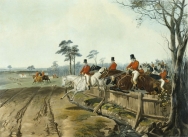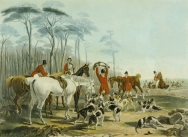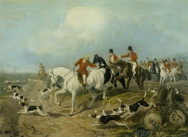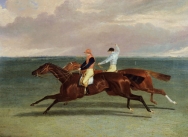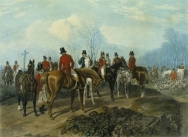A to Z of artists Herring, John Frederick (Senior) 1795 - 1865
Born in Blackfriars, Surrey, John Frederick Herring Senior was the son of Benjamin Herring (who was born in America under the British flag but was Dutch by descent), and brother of the painter Benjamin Herring Senior. John’s father was a fringe maker in Newgate Street, London and this is where John spent the first eighteen years of his life and where he was always interested in sketching and drawing. He moved to Doncaster in September 1814. Almost immediately he helped a coach painter to paint a horse on the crest of a new coach. This led to him becoming a coach driver.
He married Ann Harris. Their first child was born in 1815 and named John Frederick (born 21st June and baptised 22nd October). However a second John Frederick was born in 1820 and baptised on 22nd May 1821. This suggests that the first John Frederick had died. John had five other children. J. F. Herring Junior, Charles and Benjamin became artists. His daughters, Ann and Emma both married artists, Harrison Weir and William Biggerstaffe respectively. Although John Senior was a coach driver for nearly seven years he always recorded that he was a painter on the birth certificates.
First Charles Spencer-Stanhope and then Frank Hawkesworth tried to persuade John to give up driving and to follow art full time. Eventually he accepted Hawkesworth’s offer. He was soon painting hunters and racehorses for many notable gentry. In 1818, he first exhibited at the Royal Academy where he was to exhibit only 28 pictures throughout his life.
Some of Herring’s engravings were published in The Annals of Sporting. In 1815 The Doncaster Gazette commissioned him to sketch annually the winner of the St Leger. These were published by Messrs. Sheardown and Co. Later the plates were bought and reissued by Messrs. Fuller of Rathbone Place. He produced a series for Fullers until 1839 when he started to produce a large annual print for Messrs. Bailey, which continued until 1847. He therefore produced 33 St Leger winners in a row, and 21 consecutive Derby winners. Herring moved to Six Mile Bottom just outside Newmarket in 1830. After three years, he moved to 31 Park Street, Camberwell. He spent seven years in London, but during that time he got into financial difficulties. W. T. Copeland took up the bills and provided a house on his estate at Leyton, Essex. Copeland commissioned many pictures, amongst which were hunting designs that were used as transfer decoration on Copeland Spode bone china.
In 1840-41 Herring visited Paris by invitation of the Duc d’Orleans for whom he painted a number of pictures, some of which were published simultaneously in France and England. In 1845 he was appointed painter to the Duchess of Kent. This was followed by the patronage of Queen Victoria. His finances improved so that by 1853 he could take a lease on Meopham Park near Tonbridge. His subject range broadened from his racehorses so that he painted almost solely farmyard scenes and narrative pictures.
At Meopham he lived the life of a country squire and employed several staff. He worked daily with the assistance of his son Charles. Charles died in 1856 but John Frederick continued to work until his death. He died on 23rd September 1865 and was buried at St. John the Evangelist, Hildenborough, Kent.
A large number of his works were engraved. He contributed to The Sporting Review (1842-46), Illustrated London News (1844-45, 1864), The Illustrated Times (1859) and Bell’s Life in London.
Source: The Dictionary of British Equestrian Artists by Sally Mitchell (1985), published by the Antique Collectors’ Club.
He married Ann Harris. Their first child was born in 1815 and named John Frederick (born 21st June and baptised 22nd October). However a second John Frederick was born in 1820 and baptised on 22nd May 1821. This suggests that the first John Frederick had died. John had five other children. J. F. Herring Junior, Charles and Benjamin became artists. His daughters, Ann and Emma both married artists, Harrison Weir and William Biggerstaffe respectively. Although John Senior was a coach driver for nearly seven years he always recorded that he was a painter on the birth certificates.
First Charles Spencer-Stanhope and then Frank Hawkesworth tried to persuade John to give up driving and to follow art full time. Eventually he accepted Hawkesworth’s offer. He was soon painting hunters and racehorses for many notable gentry. In 1818, he first exhibited at the Royal Academy where he was to exhibit only 28 pictures throughout his life.
Some of Herring’s engravings were published in The Annals of Sporting. In 1815 The Doncaster Gazette commissioned him to sketch annually the winner of the St Leger. These were published by Messrs. Sheardown and Co. Later the plates were bought and reissued by Messrs. Fuller of Rathbone Place. He produced a series for Fullers until 1839 when he started to produce a large annual print for Messrs. Bailey, which continued until 1847. He therefore produced 33 St Leger winners in a row, and 21 consecutive Derby winners. Herring moved to Six Mile Bottom just outside Newmarket in 1830. After three years, he moved to 31 Park Street, Camberwell. He spent seven years in London, but during that time he got into financial difficulties. W. T. Copeland took up the bills and provided a house on his estate at Leyton, Essex. Copeland commissioned many pictures, amongst which were hunting designs that were used as transfer decoration on Copeland Spode bone china.
In 1840-41 Herring visited Paris by invitation of the Duc d’Orleans for whom he painted a number of pictures, some of which were published simultaneously in France and England. In 1845 he was appointed painter to the Duchess of Kent. This was followed by the patronage of Queen Victoria. His finances improved so that by 1853 he could take a lease on Meopham Park near Tonbridge. His subject range broadened from his racehorses so that he painted almost solely farmyard scenes and narrative pictures.
At Meopham he lived the life of a country squire and employed several staff. He worked daily with the assistance of his son Charles. Charles died in 1856 but John Frederick continued to work until his death. He died on 23rd September 1865 and was buried at St. John the Evangelist, Hildenborough, Kent.
A large number of his works were engraved. He contributed to The Sporting Review (1842-46), Illustrated London News (1844-45, 1864), The Illustrated Times (1859) and Bell’s Life in London.
Source: The Dictionary of British Equestrian Artists by Sally Mitchell (1985), published by the Antique Collectors’ Club.
Other works of art you may be interested in
Copyright © 2025 BSAT, All rights reserved
This website uses cookies and similar technologies to give you the very best user experience, including to personalise advertising and content. By clicking 'Accept', you accept all cookies.


